140-mile float on Willamette Water Trail offers backyard wildlife, solitude, camping
I hadn’t expected to need my camera so soon after beginning a 140-mile paddle down the Willamette River, but shortly after launching from Whitley Landing just outside downtown Eugene, a deer swam into the river and held its line across the swift current right in front of my boat.
I filmed the deer as it worked its way towards shore. It stepped onto the bank, raised and shook water off a hindleg, then started up into the woods. Soon the backchannel fed into the mainstem of the river.
It was just after 8 p.m. as I cruised through floating cotton fluff released from trees flickering gold in the evening sun. A juvenile bald eagle stood on a little rock island. A blue heron pumped its wings as it flew downriver, past a pair of common mergansers watching me from a log.
Say this about the Willamette: even though you’re often close to civilization, there is often an abundance of wildlife.
My plan for the first day of a long journey — which spanned from Eugene toMollala State Park in Canby — was planned out on a map purchased online from Willamette Riverkeeper. It showed a pocket of Oregon Parks and Recreation Department land a couple miles downstream that would make a good camping spot for the night.
The Willamette River Trail includes over 200 miles that provide access for paddlers to the Willamette River. There are numerous boat ramps and developed and primitive campsites like ones I was aiming to use over the course of my 140-mile journey that would take four days and three nights.
Explore Oregon Podcast: Everything you need to know about paddling and camping the Willamette Water Trail
Overall, the solitude of the trail surprised me most — I set out to explore a river flowing near many of our backyards, and did not expect to paddle for hours at a time without seeing another boat or person. The river is especially peaceful outside of towns where it jags away from county highways and roads. The mapping of islands and shoreside campsites by the Willamette Riverkeepers was spot on.
Because of shuttle availability, I started late my first night — my wife was able to get off work an hour early to drive me to Eugene and my put-in point. I traveled three miles from Whitley Landing to a campsite at Hileman Landing (formerly Beacon Landing), a little nook that I pulled my kayak into. The mosquitoes weren’t biting, and I blew up my air mattress and slipped into my sleeping bag. I could hear the water riffle, and the air felt cool and fresh. Now and then the crack of a beaver tail ricocheted into the night.
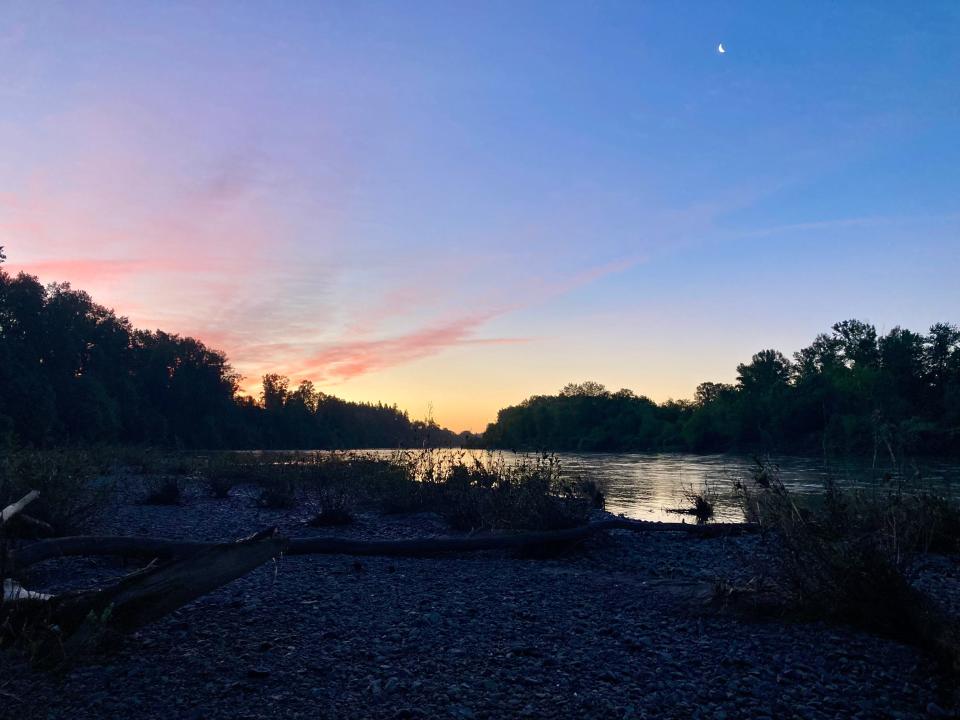
Day Two: Hileman Landing to Luckiamute Landing (64 river miles)
Morning coffee was accompanied by a choir of birdsong. The river was sparkly as I put in. Swollen with recent rains, making the Willamette higher than normal, I was unsure how the hazard warnings on the map would play out in reality.
After packing my gear and getting back on the river, I shortly floated to Blue Ruin Island, about 7 miles downstream. Blue Ruin is a few public acres among more than a thousand managed by OPRD, part of the Willamette River Greenway. Greenway spots are used to stitch together rustic campsites like the one I used last night. Preservation of native flora and fauna and protection of scenic river views and historical sites are inherent to the Greenway project.
Crickets were chirping as I glided by Harrisburg. A train whistle blew in the distance, and a bald eagle perched high in a cottonwood. I hopped out to stretch at McCartney Park, now 16 miles into the day. An osprey surveyed from a nest built on one of the many perches along the Water Trail.
At a wide bend between Harkens Lake and Irish Bend, I caught a glimpse of the shadowy foothills of the Cascades. A kingfisher flew beside me in spurts for a quarter-mile, then disappeared into a hole in the bank of Norwood Island, privately owned land with a conservation easement for restoration which includes a provision for campers using the trail.
Acrobatic swallows skimmed the water as I pulled onto a beach for lunch. Deer and bird tracks dotted the hot dark sand. There was a good view of Mary's Peak to the west, a faint quarter moon hovering above.
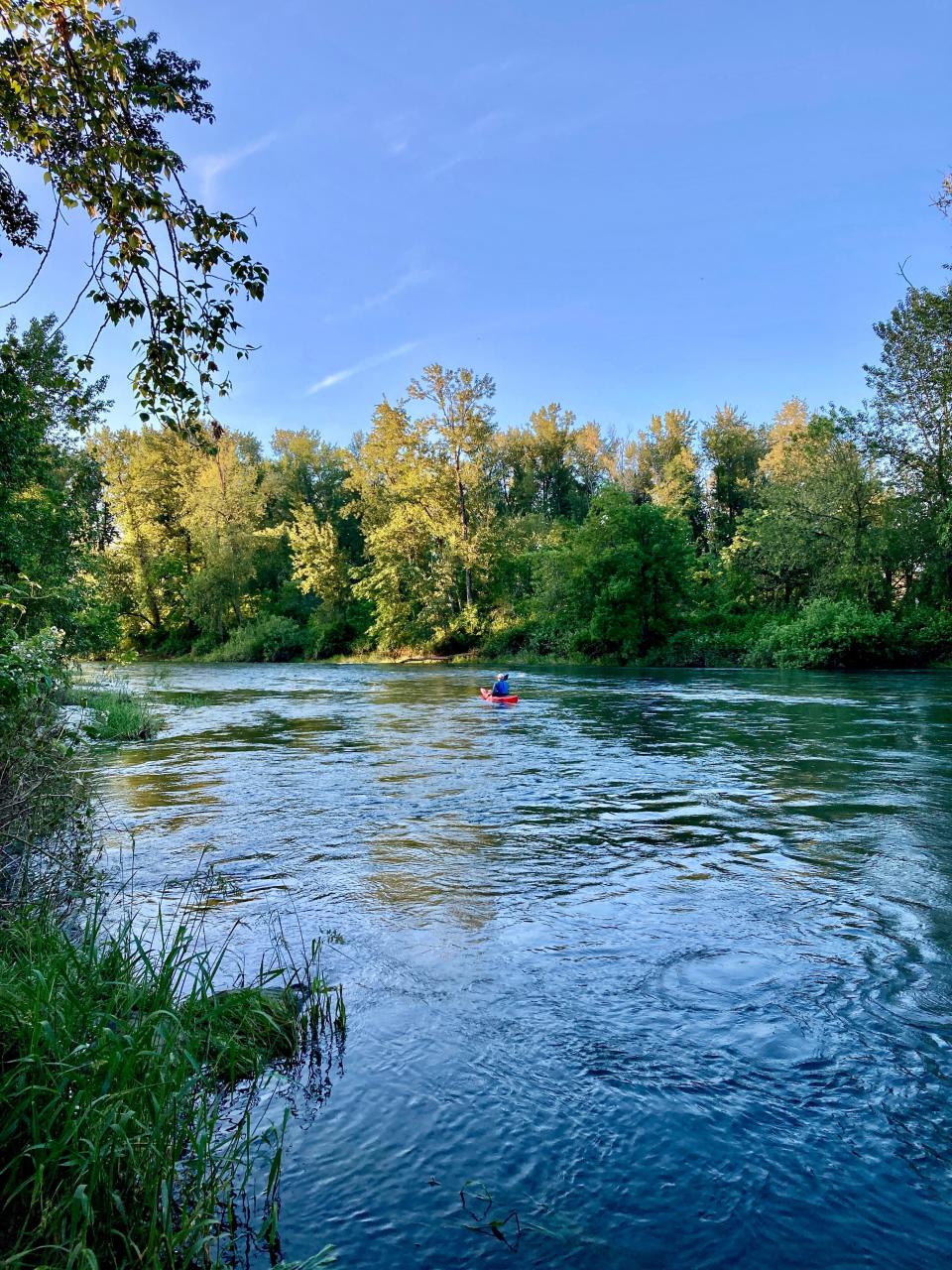
Nearing 30 miles of paddling, I approached Snag Boat Bend, just south of the town of Peoria. It’s a 340-acre refuge folded into the Willamette Valley National Wildlife Refuge Complex, a patchwork of refuges from Corvallis to Salem, critical habitat for migratory and local wildlife.
I took another break in Willamette Park in Corvallis. People were hanging out near the river, which throughout my trip felt like a ribbon of calm in our often chaotic world.
Near the town of Albany, around 5 p.m. and after 50 miles paddled for the day, I stopped to refill water. I had trouble locating the water source, but a woman kindly offered to share some she had in her car.
I began crisscrossing the meandering river to catch bits of shade. As evening approached the birds began to sing and fish jump and deer appear. The surface turned glassy. With the wind high above, so much cotton was released it seemed I was paddling in a snow globe.
Luckiamute Landing was a reputedly good place to camp. Sure enough, among these hundreds of acres of Greenway-designated land was a peaceful campsite tucked in knee-high daisies and California poppies backed by tall cottonwoods.
I awoke at one point that night and saw the Milky Way slicing the night sky, remembered I was in a beautiful pocket of earth, and drifted back off.
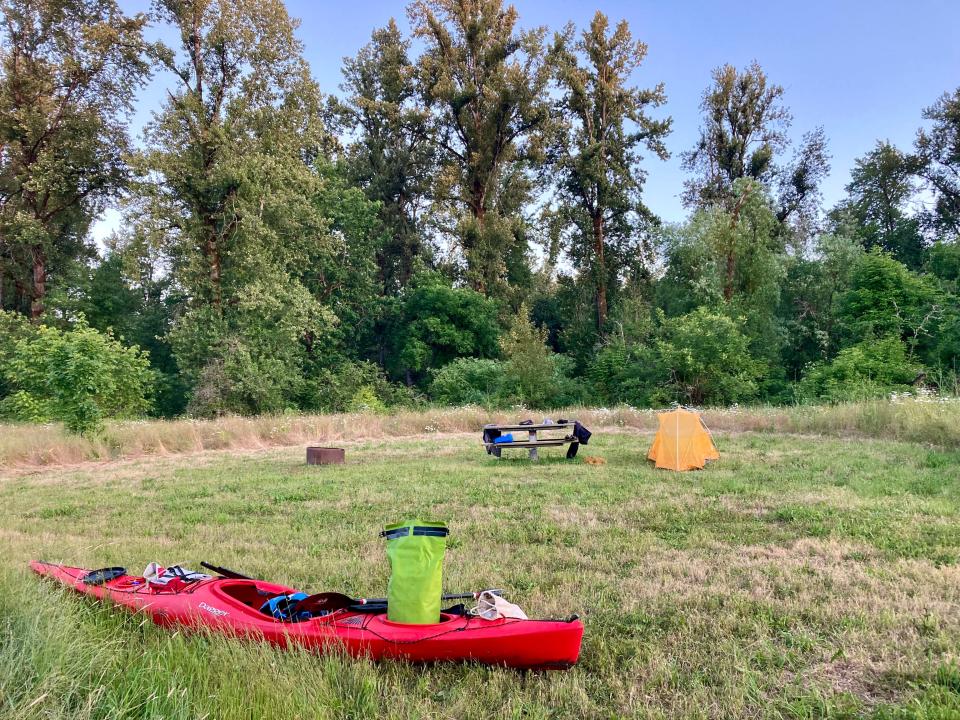
Day Three: Luckiamute Landing to Yamhill Landing (50 river miles)
Dawn brought a riot of birdsong — so many species singing the world awake. The campsite had a picnic table and nearby porta-potty, amenities that could seem "unnatural" but that ultimately helped campers lighten their footprints.
I was looking forward to a muffin in Independence, a town with a corner cafe 13 river miles away. When I pulled to shore a woman was sifting through rocks with a long stick attached to a metal fork.
"You caught me talking to myself," she said.
"It's okay," I said. "I do it all the time."
She said she collected agates in her free time. She polished them up and sold them in jewelry or made her own art; she was currently working on a fountain.
In Independence, I stopped and I carried my paddle with me to Brew Coffee and Taphouse, where I grabbed a banana walnut muffin.
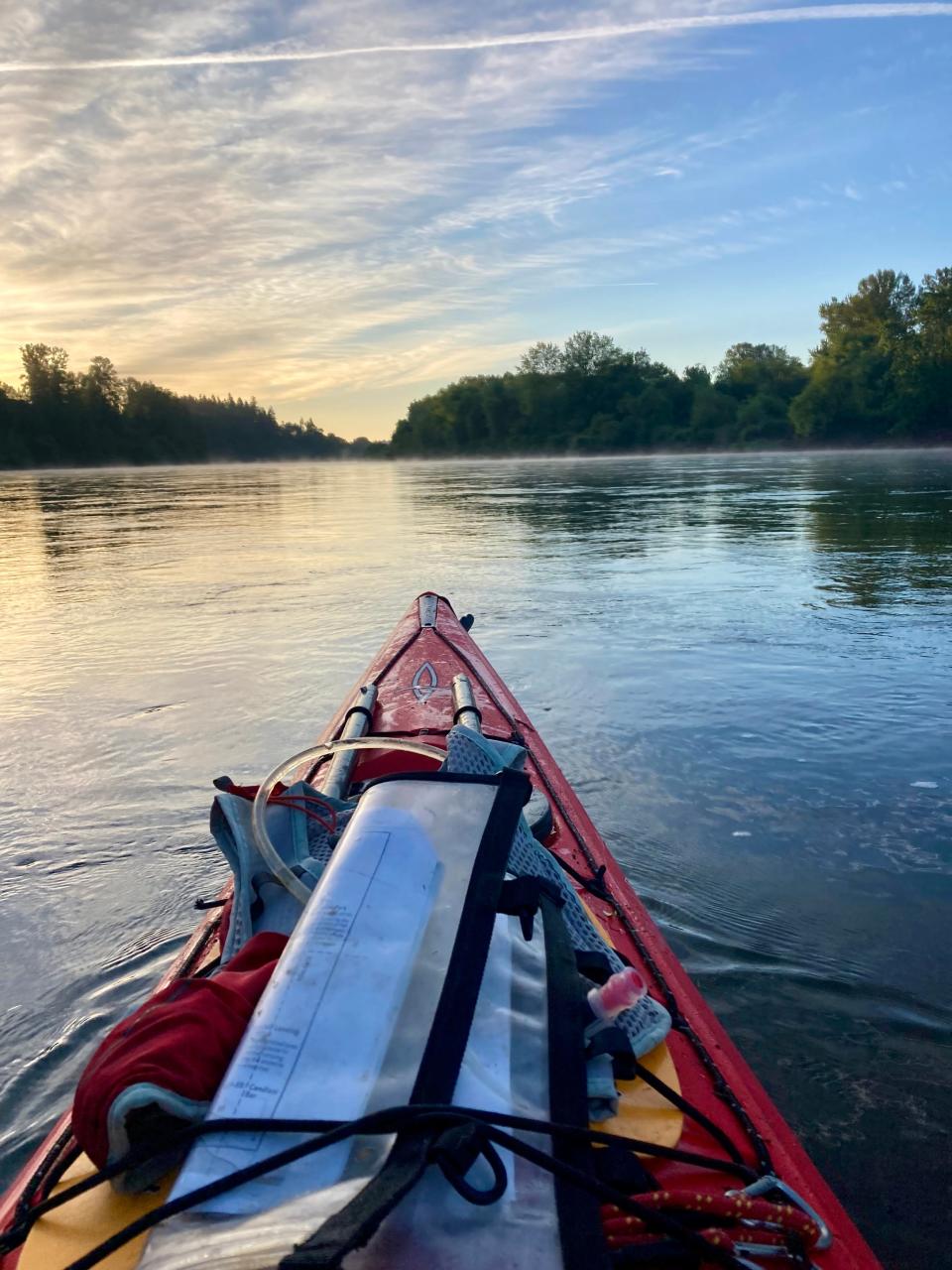
It was late morning and I hugged the eastern shore where it was still shaded, spotting the lemon-yellow tail tips of a cedar waxwing in flight and a raccoon who turned its head to eye me as it slowly walked up a mossy trunk. A hummingbird chased a kingfisher into the trees. A deer, as I neared Salem, stepped out onto a gravel bar as machines beeped and huffed in the nearby quarry.
Kids splashed in a playground fountain as people took lunchtime strolls at Salem's Riverfront Park. A kayaker with a fishing rod strapped to his deck came over to the dock.
"Lots of dragon flies back in that slough," he said. "Some frogs, too."
Back out of town, downstream of Salem, I surveyed the long grassy bench of Spongs Landing as big puffy clouds formed. I counted my seventh bald eagle of the day near Willamette Mission State Park, soaring high over the tall fir trees.
The 10 miles from Willamette Mission to a cluster of unnamed public islands were among the most enjoyable. For an hour I didn't paddle, sticking my legs out of the cockpit and cupping my hand now and then to correct position. In the backchannel of Five Island a beaver swam from the pyramid-shaped start of a dam.
The goal was to press on to Candiani Bar, a large island that the map said was good for wildlife viewing. By evening I was walking around the flattened grasses near the front side of the island. There were faint traffic sounds, and struck by upgrade fever, I hopped in the boat to check out the backchannel.
The current was strong, with no discernible eddy. After a botched attempt at landing in muck I let the water whisk me out to the mainstem.
I ended up camping on a sliver of rocks and sand called Yamhill Landing. The river must have receded a day or two earlier — there were pools here and there, and the sand was mostly still wet. I found a spot for my sleeping pad. Fearing a boat wake, potentially even sneezing, might wash me away, I slept fitfully under another beautifully starry sky.
Day Four: Yamhill Landing to Mollala River State Park (23 river miles)
Far up the Willamette Valley in the pinkening 5 a.m. sky were three hot air balloons. Mist rose from the river's surface. The taps of a woodpecker echoed like a creaky wood door opening.
The map noted that I was entering the Newberg Pool, where the river widened and slowed, and sure enough the next 20 miles — punctuated by a stop in the pretty Champoeg State Park — were a slog. I put on music and tried to dance through it.
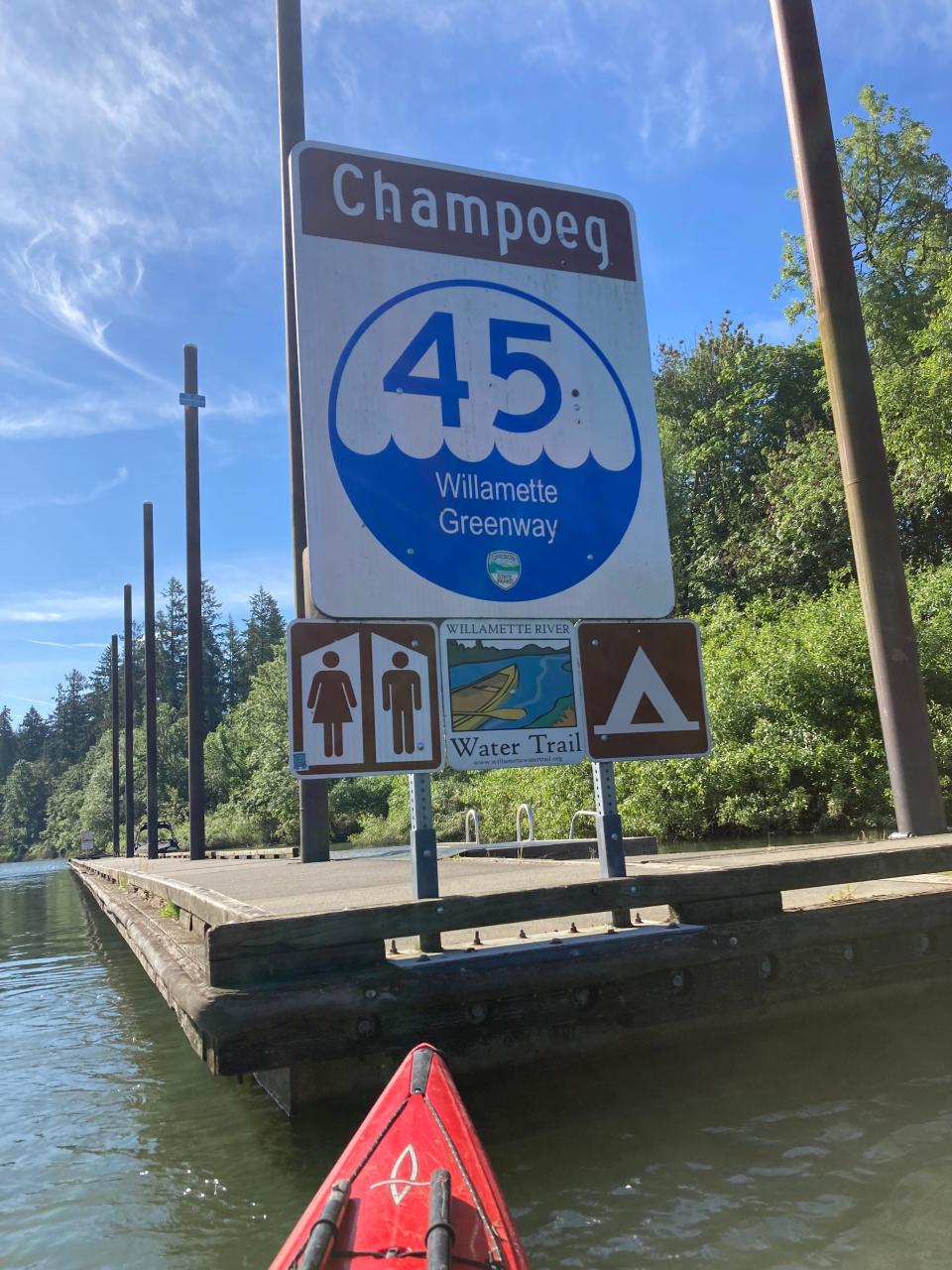
I was happy for the wildness of tree snags as I neared the Mollala River. Muddy water from the tributary swirled into the Willamette, the sound of riffles cutting the still air. Mount Hood peeked out from behind treetops near the boat ramp.
My trip ended at Molalla River State Park, where I was picked up by my brother and the dog he was watching. The three of us loaded up my kayak and gear and were soon driving home.
One of 20 national water trails, the Willamette River Trail is a treasure right in our backyard. I left the paddle feeling gratitude for the people who saw hope in these miles, who continue to do the work needed to assure future generations hear riffles and beaver tail slaps and birdsong as they weave their way downriver.
Paul Lask is a freelance outdoors journalist and writing instructor at Oregon Coast Community College. His work is at prlask.com, and he can be reached at paulrlask@gmail.com.
This article originally appeared on Salem Statesman Journal: Willamette float offers backyard wildlife, solitude, camping

